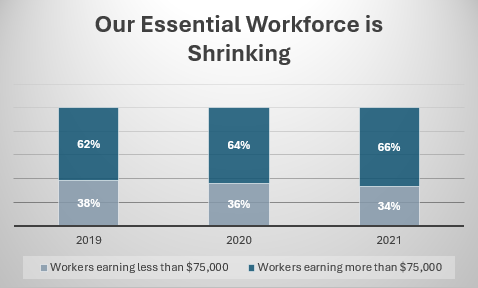The Great Migration
The Great Migration: Understanding Why Those Earning Under $75K Are Leaving North Fulton County
In recent years, North Fulton County has witnessed a significant demographic shift that underscores a broader narrative about affordability, quality of life, and the quest for financial stability. A closer examination of the US Census data from 2019 to 2021 reveals a telling trend: a steady decline in the number of residents earning less than $75,000 annually. This shift raises pertinent questions about the underlying causes and the broader implications for the community and its future.
The Numbers Speak
Between 2019 and 2021, the workforce earning under $75,000 in North Fulton County experienced a noticeable decline. In 2019, there were 55,949 individuals in this earning bracket. By 2020, this number had decreased to 54,773, and in 2021, it further slipped to 51,305. Conversely, the population earning over $75,000 saw an opposite trajectory, swelling from 91,566 in 2019 to 101,587 by 2021.
Unpacking the Exodus
Several factors contribute to this demographic shift, each intertwined with the others in a complex tapestry of economic and social dynamics.
1. Rising Cost of Living
North Fulton County, like many affluent suburbs, has seen its cost-of-living soar. Housing prices, in particular, have outpaced wage growth, especially for those in the under $75K earning bracket. As affordable housing becomes scarcer, lower and middle-income residents find it increasingly difficult to keep up, pushing them to seek more affordable pastures.
2. Changing Job Market
The job market in North Fulton County has been evolving, with a significant uptick in high-paying tech and professional jobs. While this economic shift benefits those with the requisite skills and education, it marginalizes those without, compelling them to relocate to areas with more accessible employment opportunities.
3. Quality of Life Considerations
Quality of life is a multifaceted consideration encompassing everything from commute times and access to public services to the general cost of living. As these aspects become strained under the weight of economic disparity, those earning less than $75K increasingly view relocation as a pathway to a better life.
4. Socioeconomic Polarization
The demographic shift also reflects a broader trend of socioeconomic polarization, where the middle class is eroded in favor of a more pronounced divide between the high and low ends of the income spectrum. This polarization can lead to social stratification, reduced economic mobility, and a fragmented community fabric.
Implications for North Fulton County
The departure of those earning under $75K from North Fulton County carries profound implications. Economically, it could lead to a labor shortage in essential workers, such as teachers, nurses, and public safety officers. Socially, it risks creating a monoculture that lacks the diversity of thought, background, and experience vital for a vibrant community. Politically, it may shift local governance priorities in ways that further entrench economic disparities.
Looking Forward
Addressing this exodus requires a multifaceted approach. Policies aimed at increasing affordable housing, expanding public transportation, and fostering job opportunities for a broader range of skill levels can help. Additionally, community initiatives that bridge the income divide and encourage inclusivity could counteract the trend of socioeconomic polarization.
The departure of lower and middle-income residents from North Fulton County is a wake-up call, signaling the need for introspection and action to ensure the area remains welcoming and accessible to all, irrespective of income. By addressing the factors driving this demographic shift, North Fulton can work towards becoming a more balanced, diverse, and resilient community.
